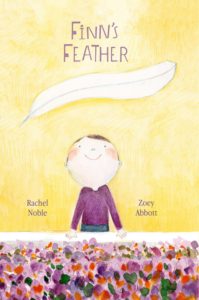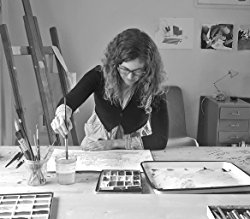Interview by Clara Martin.

When Finn finds a feather on his doorstep, he knows that it is a feather sent from Heaven from his brother Hamish–who died and is now an angel. When he shows his mom and his teacher a feather, they give him a smile and a hug. With his friend Lucas, it is different. Lucas and Finn take the feather on an adventure. They giggle when the feather tickles them, they build castles, climb trees, and look up at the sky–all with Finn’s Feather in tow. Finn’s Feather is a beautiful book about friendship, dealing with sadness, and remembering our loved ones.
Come to Story Time on the Porch at the Eudora Welty House and Garden this Thursday, June 21 at 3 p.m. to craft a feather pen, write a letter to a friend, and meet the team behind Finn’s Feather.
Author Rachel Noble and Zoey Abbott will be at Story Time on the porch reading their book, helping with the craft, and signing books that will be available for purchase through Lemuria Books.
Here, I interview author Rachel Noble and illustrator Zoey Abbott on their picture book, Finn’s Feather.
 Where are you from, Rachel, and what is your background in relation to writing children’s books?
Where are you from, Rachel, and what is your background in relation to writing children’s books?
RN: I live in Queensland, Australia with my husband, four children, dog and kitten. Before becoming a writer, I was a journalist, radio producer and voice-over artist. After the loss of my son Hamish in 2012, I started writing constantly. I don’t know how or why I started writing picture books but I suspect I wasn’t finished telling my son stories. I also realised I’ve been reading picture books to my children for 15 years and perhaps I had a few stories inside of me!
You were inspired to write this story after the loss of your own son. Did this story come in bits and pieces or all at once?
RN: All at once! Like a flash of lightning! I was driving home from my daughter’s netball game and the plot for Finn’s Feather came into my head. I immediately burst into tears. I was terrified I would forget the story by the time I got home, so I replayed it over and over in my head. When I got home, I found a feather on my doorstep and I decided that this story needed to be in the world.
What was the experience of writing this story for you, and how did you know you wanted it to be for picture book age children?
RN: I’ve written stories about grief for all ages, but I felt there was a need for a picture book told from the perspective of a sibling. This was something I looked for after Hamish passed away and couldn’t find. I felt that if I was looking for it, perhaps other people were too.
Why do you think it is important for picture books for young children to contain seemingly difficult subjects such as death, grief, and hope?
RN: Picture books are a wonderful, gentle way to approach difficult topics. We live in a world filled with challenges and I believe it is through stories we can tenderly prepare our children. I think Finn’s Feather looks at grief in an innocent and tender way, but I also love that it looks at broader themes such as empathy and resilience–all children can benefit from Finn’s story.
Who do you hope your picture book reaches, and what would you like readers to take away?
RN: I hope Finn’s Feather flies into the hands of every child who needs to read its story of hope and friendship. I also hope that every child (and parent) who reads it, feels a little lighter afterwards.
Who would you write a letter to, and why?
RN: I would write a letter to Hamish (just like Finn does in Finn’s Feather). Wouldn’t it be wonderful if there was a mail box in Heaven?
 Where are you from, Zoey, and what is your background in relation to illustrating children’s books?
Where are you from, Zoey, and what is your background in relation to illustrating children’s books?
ZA: I live in Portland, Oregon with my husband, two children and a big dog named Carrots. Over the years I have loved bookmaking, painting, drawing and ceramics. The biggest kismet moment for me was finding a children’s book illustration class taught by Victoria Jameison (Newbury Award Winning author/illustrator of Rollergirl) at Pacific Northwest College of Art. She is the teacher that got me on this particular path. I am forever grateful.
When you saw this manuscript, there was obviously the image of the pristine white feather, but you use such bright and colorful images to balance it. What was your artistic process in creating this book?
ZA: When I first read the manuscript I was overwhelmed by it’s tenderness and truth. I could not believe that I was being offered and opportunity to illustrate this beautiful story and from THE publisher I had admired and loved a for over a decade, Enchanted Lion Books.
When I researched who Rachel was and found out that Finn’s Feather was based on her own family story, I felt even more of a desire to make the book as “good” as I was able. Deciding to make something “good” can really get in the way of making something “true”. It took time and I had to dig deep to get to the truth. Our publisher, Claudia Bedrick, and I did a lot of work together to get to the essence. She guided me in this discovery. At one point my agent also said to me, “Don’t worry so much about making it good just make it your own.” That sliced to my soul. I had to figure out what the story meant to me.
It became important to me to show the great range of emotions in the story, including immense joy. I also wanted Hamish’s presence to be felt in nature, and for nature to be a link to Hamish. I looked at the paintings of Nicholas Roerich, Albert Bierstadt and Milton Avery, works that felt spiritual and big and light filled. I think these intentions and inspirations came through in the brightness and color.
How did you choose to illustrate the evolution of Finn’s feather from Finn’s discovery of the feather to almost losing it, and the adventures the feather goes on?
ZA: A picture book is a strange beast. It is two stories, on layered on top of the other. The words comes first, then the images. If the illustrations just describe what is in the text, it is received as flat. The task of the illustrator is to love the story and look for another essence somewhere between the lines. What is there that isn’t there?
Early on I felt like the best thing I could add to the story as the illustrator was bringing the gift of the feather back full circle. What else could the feather be used for? The last line was such an invitation and a challenge. It felt so right when I realized Finn could write a letter back to Hamish accompanying Rachel’s beautiful last lines, “The feather was no longer white, no longer perfect but it was still amazing.”
Who would you write a letter to, and why?
ZA: I lived in Japan for four years and I have been wanting to write a letter to my sumi-e brush painting teacher, Shihan. She would be in her 90’s by now. Her family lived far up north and mine lived across the Pacific ocean so she would invite me to her house for lunch every Sunday after class. We made traditional Japanese foods together while we talked about art, history, life and meaning. She was 80 and I was 24. I miss her.
I had better start writing that letter …


Comments are closed.